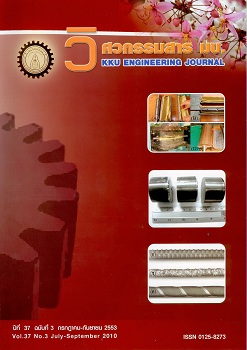A study of flow in an ejector equipped with variable throat area of the primary nozzle using CFD simulation
Main Article Content
Abstract
The aim of this research is to study a flow in an ejector equipped with variable throat area of theprimary nozzle. Using a CFD technique, flow phenomena, mixing structure and performance of the ejectorwere analyzed and explained. In this study, a 2D-axisymetric model was used. Realizable k-epsilon modelwas applied for a turbulence model. R141b was selected as a refrigerant fluid. Instead of changing the size ofthe throat diameter, variation of throat area of the primary nozzle was achieved by changing a wedgesposition. The wedges position or the needle tip position (NTP) is defined as a distance between a plane ofneedles tip and a plane of the primary nozzles throat. Results show that altering the needle tip position (NTP)affects the ejectors performance. For example, changing the NTP to 0, 5 and 10 mm., under the primary fluidsaturated temperature of 100 sC and the secondary fluid saturated temperature of 5 sC, the entrainment ratiowas subjected to increased from 0.24 to 0.30, and 0.52, respectively. While its critical back pressure (CBP)trend to reduce from 120.1 kPa to 112.2 kPa and 84.5 kPa. The results of this study were verified with a CFDsimulation of a typical R141b ejector (Sriveerakul, 2008). A CFD simulation at 5 mm. of NTP presents a closestCFD result to the typical ejector (the ejector without a wedge).
Article Details
How to Cite
Suvarnakuta, N., Uthaikorn, K., Sriveerakul, T., & Aphornratana, S. (2012). A study of flow in an ejector equipped with variable throat area of the primary nozzle using CFD simulation. Engineering and Applied Science Research, 37(3), 181–190. retrieved from https://ph01.tci-thaijo.org/index.php/easr/article/view/1704
Issue
Section
ORIGINAL RESEARCH
This work is licensed under a Creative Commons Attribution-NonCommercial-NoDerivatives 4.0 International License.



